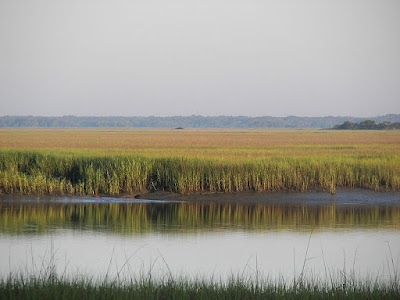 |
| Observation Tower Robinson Preserve, Florida |
It’s fall in Central Florida. This
means azure blue sky, low humidity and moderate temperatures. On this day we
visited the Robinson Preserve in Manatee County. The Gulf breeze brought
refreshing cool air to the salt marsh, attracting numerous people to enjoy the recreational benefits of the salt marsh.
We talked to one couple that had
completed a loop of the marsh in kayaks. They told us of seeing roseate spoonbills, bald eagles and a family of raccoons. The kayak vendor informed us
the masked bandits feed in that section of the marsh every morning to chow down
on clams.
We unpacked our picnic basket of
leftover turkey sandwiches and chocolate chip cookies next to the dark blue water, and watched the leaping mullet. Overhead osprey circled and chirped.
Only a few clouds adorned the sky so we decided to put on sunscreen, but we skipped
the DEET. We hoped the wind would keep the mosquitos at bay.
 |
| A Stampede of Fiddler Crabs |
After lunch we passed through the
marsh on our way towards the mangrove swamp boardwalk. At one of the ponds, we
witnessed a large collection of male fiddler crabs. It looked like something
out of a science fiction movie.
We climbed the observation tower to
get a better view of the surrounding marsh, the Gulf and the Sunshine Skyway bridge. Many kayaks and paddleboards floated on the open water at this point.
People are discovering the many recreational opportunities offered by the salt marsh. It's important to ensure the conservation of these wetland areas that fish and birds
rely on.
 |
| Sunshine Skyway bridge |
A boardwalk meanders through the
mangrove swap. It provides hikers numerous opportunities to see wildlife. Along one section it follows the Gulf shore. Fisherman and hikers can make their way
through the massive sea grape stands, and dip a line or their feet in the Gulf
waters. One can also get a good view of the Sunshine Skyway bridge, and
downtown St. Petersburg.
On this day we saw several osprey
and ibis. We also saw an egret and a juvenile black crowned night heron. There
were lots of hikers, bicyclists, and kayakers. On this day wildlife was minimal, however the great weather and scenery made for an enjoyable trip.
 |
| Juvenile Black Crowned Night Heron |
 |
| Osprey enjoying a fall day at the Preserve |








